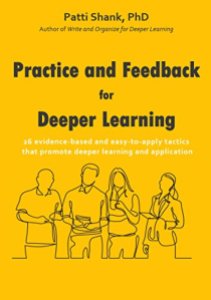Book Review: Practice and Feedback for Deeper Learning
Patti Shank’s Practice and Feedback for Deeper Learning is a summary of tactics you can use to create memorable, relevant practice opportunities and provide constructive, beneficial feedback for learners. Everything in the book is backed by research and written to be immediately usable by instructional designers and trainers.
Patti Shank’s Practice and Feedback for Deeper Learning is a summary of tactics you can use to create memorable, relevant practice opportunities and provide constructive, beneficial feedback for learners. Everything in the book is backed by research and written to be immediately usable by instructional designers and trainers.

This is the second installment in Patti’s “Make It Learnable” series, which is shaping up to be one of those sets of fundamental reading in the field of instructional design. The first book is Write and Organize for Deeper Learning; you can read my review of the first book. As with that book, this book gives you a shortcut to what really works based on evidence, without having to wade through complex (and often contradictory) research yourself. Specifically, this is based on training research, not research on K-12 or higher education learners.
Have you ever wondered…?
- How do we create practice activities that will help transfer skills to the workplace?
- Ho can we create practice activities that are more memorable?
- How can we create more effective feedback than just “correct” and “incorrect”?
- Do novice and experienced learners benefit from the same strategies?
- How do we make sure learners are practicing the right skills and behaviors?
- How can we help learners deal with errors and mistakes?
- If we’re training a complex task, should we divide the task into small parts or train a simple version of the whole task?
- Is it better to give feedback right away or to delay it?
- What kinds of realism are important to training practice? Is it necessary to use lots of multimedia to make training look exactly like the work environment?
- Is it better to set goals for specific performance levels or goals for making progress in learning?
All of these questions are addressed in this book through 5 overall strategies divided into 26 tactics.
Go buy Practice and Feedback for Deeper Learning now. Read it, and then pick something relevant to apply to your own work. After all, the best way to improve your own learning design is to practice using these tactics yourself.
This post contains affiliate links. It doesn’t cost you anything extra, but I earn a small percentage when you buy through these links.
3 thoughts on “Book Review: Practice and Feedback for Deeper Learning”